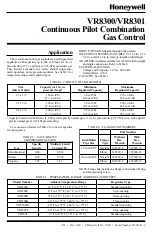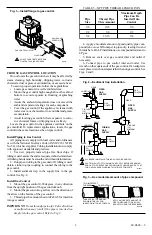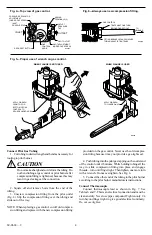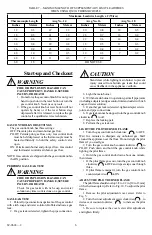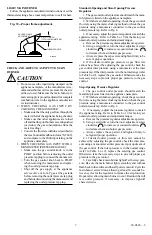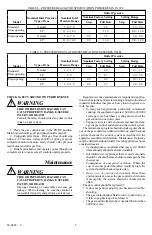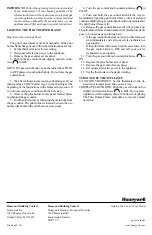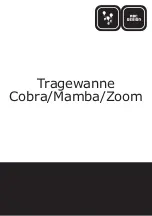
9
69-0624—2
Service
WARNING
FIRE OR EXPLOSION HAZARD CAN
CAUSE PROPERTY DAMAGE, SEVERE
INJURY OR DEATH
Do not disassemble the gas control; it contains no
replaceable components. Attempted disassembly
or repair may damage the gas control.
CAUTION
Do not apply a jumper across or short the valve coil
terminals. Doing so can burn out the heat anticipa-
tor in the thermostat.
IMPORTANT: Allow 60 seconds after shutdown before re-
energizing step-opening model to assure lightoff at
step pressure.
IF THE PILOT BURNER FLAME WILL NOT
LIGHT
1. Assure the main gas supply valve is open and the pilot
gas supply line is purged of air.
2. Attempt to light pilot burner flame following proce-
dures in the Lighting the Pilot Burner Flame section. If pilot
burner flame still will not light:
a. Check the pilot gas adjustment screw. If closed, read-
just the pilot flame. Refer to Adjust the Pilot Burner
Flame section.
b. Perform the Gas Leak Test at the compression fitting.
If a gas leak is detected, replace the old compression
fitting or tighten the newly installed one. Refer to Fig. 4.
c. Assure that the pilot burner tubing or pilot burner
orifice is not clogged.
IF THE PILOT BURNER FLAME GOES OUT
WHEN THE GAS CONTROL KNOB IS RELEASED
1. Assure the gas control knob is held in at least one
minute to allow the thermocouple time to heat.
2. Check the pilot burner flame adjustment. Refer to
Adjust the Pilot Burner Flame section.
3. Check the wiring between the thermocouple and the
gas control valve operator.
4. Assure thermocouple connection to the power unit is
tightened one-fourth turn beyond finger tight.
5. If pilot burner flame still goes out, measure the open
and closed thermocouple output voltage. Compare it to the
acceptable range charts in the thermocouple specifications
or in the Gas Controls Handbook. Replace the thermocouple
if voltages are outside the acceptable range.
6. Check the power unit resistance. If above 11 ohms,
replace the gas control.
IF THE MAIN BURNER WILL NOT COME ON
WITH A CALL FOR HEAT
1. Be sure the gas control knob is in the ON position.
2. Adjust the thermostat several degrees above room
temperature.
3. Use an ac voltmeter to measure the voltage across
terminals TH and TR or MV/PV and MV. If:
a. No voltage is present, check the control circuit for
proper operation.
b. 24 Vac is present, but first operator did not click open,
check for excessive inlet gas pressure. If inlet gas
pressure is correct, replace the gas control.
4. Measure the open and closed thermocouple output
voltages and compare to the acceptable range charts in the
thermocouple specifications or in the Gas Controls Hand-
book. Replace the thermocouple if voltages are outside the
acceptable range.
5. Measure the open and closed thermocouple output
voltages and compare to the acceptable range charts in the
thermocouple specifications or in the Gas Controls Hand-
book. Replace the thermocouple if voltages are outside the
acceptable range.
IF THE MAIN BURNER IS OVERFIRING
Adjust the gas control pressure regulator to the correct
pressure. If the regulator cannot be adjusted and supply the
pressure is in the normal range, replace the gas control.
INSTRUCTIONS TO THE HOMEOWNER
CAUTION
FIRE OR EXPLOSION HAZARD CAN
CAUSE PROPERTY DAMAGE, SEVERE
INJURY, OR DEATH
Follow these warnings exactly:
1. Pilot burner flame must be lit manually. Follow
these instructions exactly.
2. Before lighting pilot burner flame, smell around
the appliance for gas. Be sure to smell next to
floor because LP gas is heavier than air.
3. IF YOU SMELL GAS:
• Turn off the gas supply at the appliance
service valve. On LP gas systems, turn off
the gas supply at the gas tank.
• Do not light any appliances in the house.
• Do not touch electrical switches or use the
phone.
• Leave the building and use a neighbor’s
phone to call your gas supplier.
• If you cannot reach your gas supplier, call
the fire department.
4. Do not force the gas control knob. Use only
your hand to push down or turn the gas control
knob. Never use any tools. If the gas control
knob will not operate by hand, the gas control
should be replaced by a qualified service tech-
nician. Force or attempted repair can result in a
fire or explosion.
5. Replace the gas control in case of any physical
damage, tampering, bent terminals, missing or
broken parts, stripped threads, evidence of ex-
posure to heat or if flooded by water.

